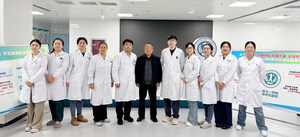High-Precision Base Editing Clinical Treatment for Sickle Cell Disease -- CorrectSequence Therapeutics' CS-101 Achieves Promising Results in First Patient
SHANGHAI, Aug. 26, 2025 /PRNewswire/ -- CorrectSequence Therapeutics Co., Ltd. (Correctseq), a clinical-stage biotechnology company pioneering transformer Base Editing (tBE) technology for the treatment of severe diseases, today announced the successful treatment of the first sickle cell disease (SCD) patient using its high-precision base-editing therapy CS-101.
The breakthrough was achieved in an Investigator-Initiated Trial (IIT) conducted in collaboration with the First Affiliated Hospital of Guangxi Medical University. The patient demonstrated a significant and sustained increase in fetal hemoglobin (HbF) levels, accompanied by a marked reduction in sickle hemoglobin (HbS). Six months post-treatment, the HbF-to-HbS ratio stabilized at 6.5:3.5, with total hemoglobin consistently exceeding 120 g/L. Over the six-month follow-up period, the patient experienced no vaso-occlusive crises (VOCs) and successfully resumed normal daily activities — marking the first reported clinical treatment of sickle cell disease in China using base editing technology.
Picture: The patient, a 21-year-old woman from Nigeria, had previously suffered from recurrent VOCs. For six months after receiving CS-101, she remains crisis-free and in good health.
Sickle Cell Disease and the Need for Curative Therapies
Hemoglobinopathies — including SCD and β-thalassemia (β-thal) — are the world's most common group of monogenic diseases, with approximately 7% of the global population carrying a pathogenic variant. Each year, around 400,000 newborns are affected. SCD, caused by mutations in the β-globin gene, leads to abnormal, sickle-shaped red blood cells, resulting in chronic anemia, recurrent pain crises, increased infection risk, and progressive organ damage. Globally, about 3.5% of the population carries the sickle mutation, with roughly 300,000 affected infants born annually, especially in Africa, the Mediterranean, the Middle East, and South Asia.
Existing treatments such as symptomatic drugs and blood transfusions can alleviate symptoms but do not offer a cure. Hematopoietic stem cell transplantation (HSCT) can be curative, but the requirement for a matched donor limits accessibility. Gene-editing approaches, particularly base editing, can activate fetal hemoglobin in a patient's own blood cells — eliminating the need for a donor and offering a shorter, potentially safer treatment path.
CS-101: Precision Base Editing for Hemoglobinopathies
CS-101 is a gene-editing therapy based on the high-precision transformer Base Editor (tBE) platform (Wang et al., Nat Cell Biol, 2021), developed by Correctseq's scientific co-founders. The therapy targets β-hemoglobinopathies by precisely modifying a regulatory element in the promoter of the γ-globin genes (HBG1/2), mimicking naturally occurring single-nucleotide variants found in individuals with hereditary persistence of fetal hemoglobin. This reactivates γ-globin expression to produce functional HbF, which prevents sickling and reduces hemolysis.
In the IIT, the patient began with a baseline hemoglobin level of 67.3 g/L. Following CS-101 treatment in February 2025, she achieved rapid hematopoietic recovery, with neutrophil engraftment in 13 days and platelet counts surpassing 50×10⁹/L in 21 days. Her HbF levels rose from 4.4% to 34.6% within one month, and since the third month post-treatment, HbF levels have remained above 60% while HbS has stayed below 40%. No VOCs or treatment-related adverse events have been reported.
A Safer, More Effective Approach
Compared with conventional CRISPR/Cas9-based therapies, CS-101 delivers efficient hematopoietic recovery and higher HbF-to-HbS ratio, without the risks of large DNA deletions, chromosomal rearrangements, or off-target mutations.
To date, CS-101 has been used to treat nearly 20 patients with β-thalassemia or SCD in clinical trials. The first β-thalassemia patient treated has remained transfusion-free for over 22 months. This positions CS-101 as a potential best-in-class gene-editing therapy — and the world's first base editing treatment — for β-hemoglobinopathies.
Global Development and Next Steps
The Phase I trial of CS-101 for β-thalassemia has been completed, with all patients achieving transfusion independence. Pivotal Phase II/III trials are set to begin soon, and global recruitment for both SCD and β-thalassemia trials is now underway. Correctseq is committed to advancing CS-101 — a first-in-class, China-originated gene-editing therapy — to deliver safe, effective, and accessible treatments for patients worldwide living with severe hemoglobin disorders.
About CorrectSequence Therapeutics
CorrectSequence Therapeutics (Correctseq), incubated at ShanghaiTech University, is dedicated to leveraging innovative gene-editing technologies to transform the lives of people with severe diseases. The company has developed multiple state-of-the-art base-editing systems that offer exceptional precision, minimize off-target effects, and enhance in vivo editing efficiency. Correctseq's mission is to discover, develop, manufacture, and commercialize curative genetic medicines across a broad range of conditions. Its robust pipeline spans genetic disorders, metabolic diseases, and cardiovascular conditions, with several programs already advancing toward clinical development.
For more information, visit www.correctsequence.com.
Acknowledgments: The First Affiliated Hospital of Guangxi Medical University, ShanghaiTech University, Shanghai Clinical Research and Trial Center.
Media Contact:
Business Cooperate: BD@correctsequence.com
Clinical Trial Recruitment: CT@correctsequence.com
Photo - https://mma.prnewswire.com/media/2757264/CorrectSequence.jpg






Share this article